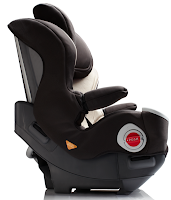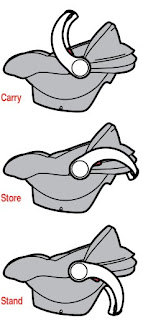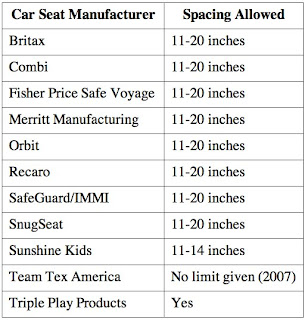WHICH LATCH ATTACHMENTS
COME WITH MY CHILD SAFETY SEAT?
Note: The following info pertains to car seats
currently sold in the US. Always refer to your child seat & vehicle owner's manuals.
INFANT SEAT WITH BASE
Rear-facing infant seats usually come with a base.
LOWER ANCHOR STRAP: permanently attached to the base
TETHER STRAP: none currently sold in the US use a tether
NOTE: When using the infant seat
without the base, you will need to use the vehicle's seat belt to secure the seat - as the lower anchor strap is permanently attached to the base (and should not be removed). All infant seats EXCEPT the following allow you to use the carrier without the base: Evenflo Cozy Carry, Evenflo Embrace (those made before 10/08),
The First Years Via (formerly the Compass I400), Peg Perego Primo Viaggio (non-SIP 30/30 versions).
 INFANT SEAT WITHOUT BASE
INFANT SEAT WITHOUT BASESometimes rear-facing infant seats come by themselves (i.e. without a base). The information below is for carriers that come without a base (for carriers that come
with a base, see above info)
LOWER ANCHOR STRAP: permanently attached to the carrier
TETHER STRAP: no infant seats currently sold in the US use a tether
****************************************************************************************************
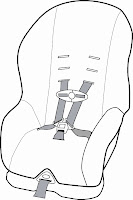 CONVERTIBLE SEAT
CONVERTIBLE SEAT (CONVERTS FROM REAR-FACING to FORWARD-FACING)
LOWER ANCHOR STRAP: permanently attached to the seat.
Most convertible seats have one long lower anchor strap with a connector on either end - while others (some Britax & Recaro for example) have 2 separate lower anchor straps each with a connector on the end. Some convertible seats have a separate lower anchor strap for rear-facing & forward facing (ex. Graco My Ride 65).
**Always make sure the lower anchor strap is routed/positioned in the proper place for the direction the seat is facing - nearly all seats require you to make some change in the lower anchor strap when the seat goes from rear-facing to forward-facing.
 TETHER STRAP
TETHER STRAP: Most convertible seats do not use the tether rear-facing.
ALL convertible seats use the tether forward-facing.
***Remember: While the lower anchors are used INSTEAD of the vehicle's safety belt to secure the child safety seat to the vehicle, tethers are used IN ADDITION to the lower anchors OR the vehicle's safety belt to secure a forward-facing (and some rear-facing) child safety seat to the vehicle.
These convertible seats can use the tether rear-facing:
-
Britax: all convertible car seats allow Swedish or Australian method
-
Combi Coccoro: will retroactively allow tethering (further info to come)
-
Snug Seat Hippo: changed 5/30/07 to retroactively allow Swedish or Australian method (this seat is for children in Spica casts)
-
Sunshine Kids Radian (all models) - tether using Swedish method
Swedish method: down to an anchor/structural piece of metal on the floor of the vehicle.
Check out this video from Britax (see step 9) which shows how to find an anchor location & how to use the tether connector strap
Australian method: to the forward-facing tether anchor
****************************************************************************************************
COMBINATION SEAT
(FORWARD-FACING 5-POINT HARNESS CAR SEAT
THAT TURNS INTO A BELT POSITIONING BOOSTER)
 5-POINT HARNESS CAR SEAT MODE
5-POINT HARNESS CAR SEAT MODE LOWER ANCHOR STRAP: permanently attached to the seat.
TETHER STRAP: All combination seats come with a tether. While the tether is technically optional on most combination seats (
but should always be used whenever possible as it decreases how far the child's head moves forward by up to 8 inches), there are a few that require the tether. For example, the
Safety 1st Go Hybrid requires the tether at all times, while the
Britax Frontier 85 requires it for children weighing more than 65 pounds who are using the 5 point harness.
***Remember: While the lower anchors are used INSTEAD of the vehicle's safety belt to secure the child safety seat to the vehicle, tethers are used IN
ADDITION to the lower anchors OR the vehicle's safety belt to secure a forward-facing (and some rear-facing) child safety seat to the vehicle.
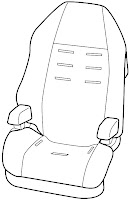
BELT POSITIONING BOOSTER MODE
Most combination seats do NOT allow the use of the lower anchor OR tether strap to secure the seat to the vehicle while the seat is being used in the booster mode (i.e. the child is using the vehicle's shoulder/lap belt across them).
Current exceptions:
- Britax Frontier & Frontier 85: allow use of lower anchors & tether
- Evenflo - all combo seats (retroactive) allow use of lower anchors & tether
- Recaro Young Sport - recommend use of tether (do not allow lower anchors)
- Safety 1st Go Hybrid (formerly Safeguard Go) - allow use of lower anchor
- Nania Airway & Nuevo/Solo - allow use of lower anchors & tether
****************************************************************************************************
 HIGH- BACK BELT POSITIONING BOOSTER
HIGH- BACK BELT POSITIONING BOOSTER: None of the high-back boosters (that weren't part of a combination seat) currently come with a tether strap.
LOWER ANCHOR STRAP: Most booster seats do not come with lower anchor connectors - however, the few that do most often have rigid lower anchor connectors (instead of a flexible lower anchor strap as is found on nearly every other type of car seat). See close-up drawing at left of a rigid lower anchor connector.

The following high-back boosters allow the use of the lower anchors:
-
Cybex Solution X-fix - rigid lower anchor connectors
-
Jane Indy Plus - rigid lower anchor connectors
-
Magna Clek Oobr - rigid lower anchor connectors
-
Sunshine Kids Monterey - (flexible) lower anchor connectors
****************************************************************************************************
BACKLESS BELT POSITIONING BOOSTER
 TETHER STRAP
TETHER STRAP: No backless boosters use a tether strap.
LOWER ANCHOR STRAP: Most do not have a lower anchor strap/connector
The following backless boosters allow the use of the lower anchors:
-
Magna Clek Olli & Ozzi - rigid lower anchor connectors
-
Safety 1st Go Hybrid - flexible lower anchor connectors
-
Sunshine Kids Monterey - (flexible) lower anchor connectors
****************************************************************************************************
(FUNCTIONS LIKE A BELT POSITIONING BOOSTER)
LOWER ANCHOR STRAP: Does not have a lower anchor strap
TETHER STRAP: tether must be used when using a lap-only belt, and may be used for extra support when using a shoulder belt.






